Drones have become some of the most popular electronic toys for kids and adults alike, but how are they so cool? For starters, quadcopter drones fly very differently than a regular helicopter or airplane. The quadcopter motor direction abilities range and allow for users to perform a wide variety of tricks. Despite their unique design, they’re also relatively easy to control, which makes them an easy choice for anyone looking for electronic toys.
Having a solid understanding of how quadcopters work is integral in the process of learning how to properly operate the drone. Continue reading to learn everything you need to know about quadcopter correct motor direction and how to find the best quadcopter drone propellers.
In this post, you will learn a lot about quadcopters, including how they work, motor and propeller direction, quadcopter sizes, and so much more. Rest assured that by the time you’re done reading this article, you’ll have become a total expert.
A quadcopter works just the way its name implies. This particular drone uses four motors with four propellers to initiate thrust. The thrust created from the motors and propellers is what then helps the quadcopter reach liftoff.
To get more specific, two of the motors rotate counterclockwise while the other two go in the opposite direction (clockwise). Rather than propelling itself forward on the ground, the thrust created from the opposing motors forces the torque to cancel out, and all of the energy created is moved underneath the drone.
Not only are drones a popular toy for leisure time, but they can also be extremely beneficial for a variety of reasons. For starters, many photographers use drones to get the footage they wouldn’t be able to capture with a regular camera. On top of that, drones have been used for military operations, in journalism and film, disaster management and rescue operations, and healthcare.
General Leisure Use
Aside from using them for play, some have even taken the opportunity to embrace the “drone selfie.” Drone selfies are essentially the same thing as using a selfie stick, but instead of a stationary stick, you use your drone at just the right angle. Drone selfies are perfect for taking photos of large groups without worrying about leaving anyone out.
Another popular leisure activity comes in the form of drone racing. Quadcopters are a popular choice in this up-and-coming hobby specifically because of the thrust it allows for. To do this, racers will strap a VR headset on, and this allows them to follow their drone through wooded and rocky areas where it may be tricky to see.
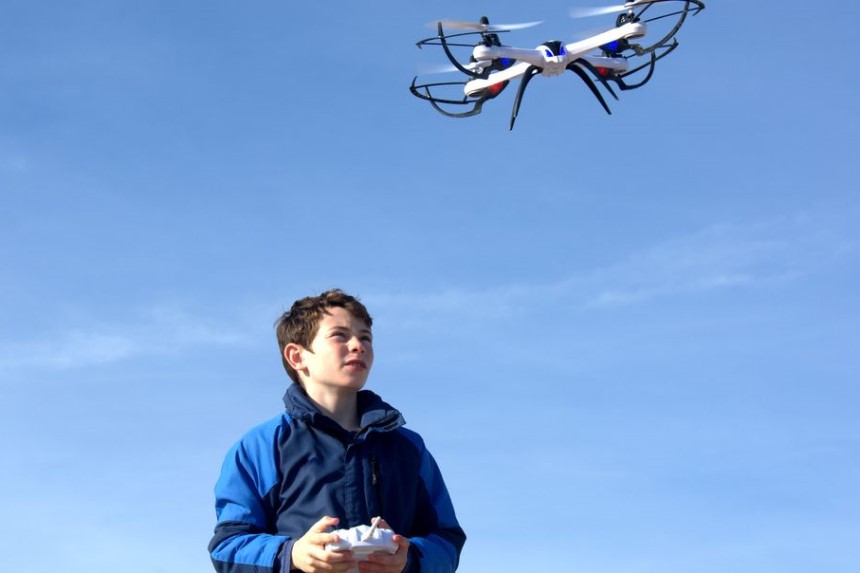
Children can benefit from using toy drones by learning more about the laws of physics.
Military Operation
Drones have been a common military tool since they were first invented. As a matter of fact, the United States is said to have begun research on and using drones back in 1917. Today, quadcopter drones are used in a variety of different military operations.
For starters, drones are excellent when it comes to bombing detection. Because of their size, it’s much easier for them to maneuver through tricky spaces. Their maneuverability, along with the ever-evolving military technology available, makes them the optimal choice for safely navigating through bomb fields.
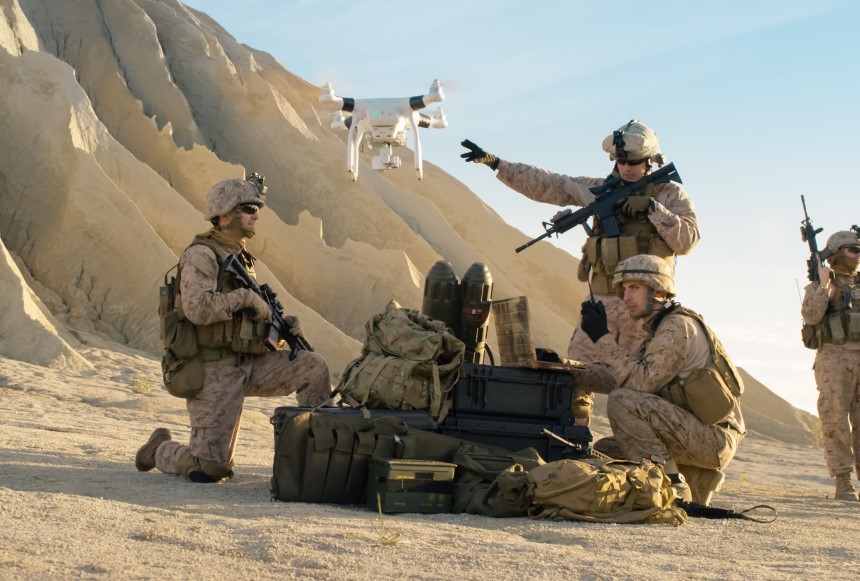
Drones have been used by the military for many years.
Although they’re good for bomb detection, drones are more known for military use as surveillance mechanisms. Drones are commonly used to spy on potentially dangerous areas, and they do so successfully because of their size and low noise level.
Journalism and Film
Just like aerial photography, quadcopter drones have the ability to give journalists and filmmakers more thorough shots than they could get with a regular camera. Drones have been used in countless films and television series, including the Harry Potter franchise and Game of Thrones.

Drones industry introduced new ways of filming.
Disaster Management
Quadcopter drones are an extremely beneficial tool for disaster management, especially when human lives may be at stake. For example, if a natural disaster causes excessive building damage and people are potentially inside the rubble, a drone can locate them and make recovering the injured much easier.
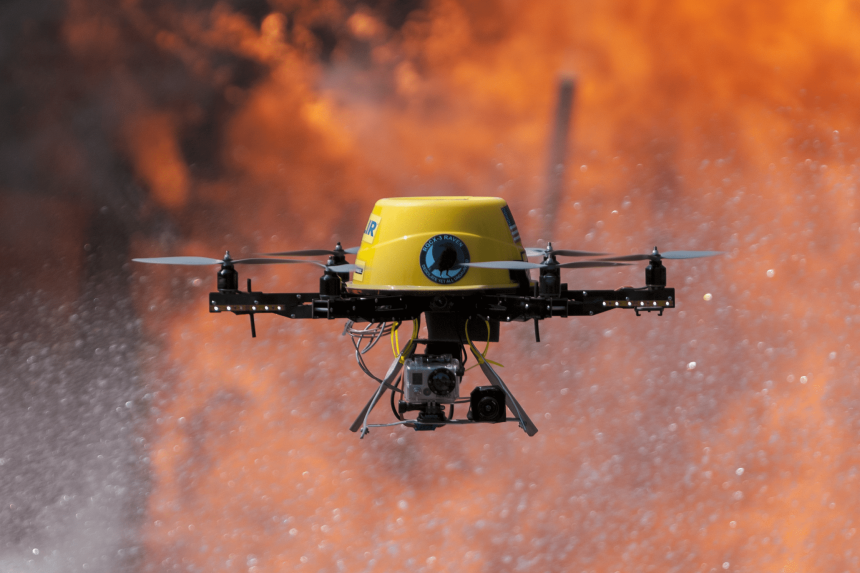
Drones can also be used to help with wildfires.
Rescue Operations/Healthcare
Drones may also be used to drop off necessary medical supplies in certain emergency situations. Let’s say you’re somewhere remote in the mountains. If a rescue helicopter has located you, but they can’t reach you right away, they could send down a drone with necessary supplies to stabilize whoever is injured until other help can arrive.
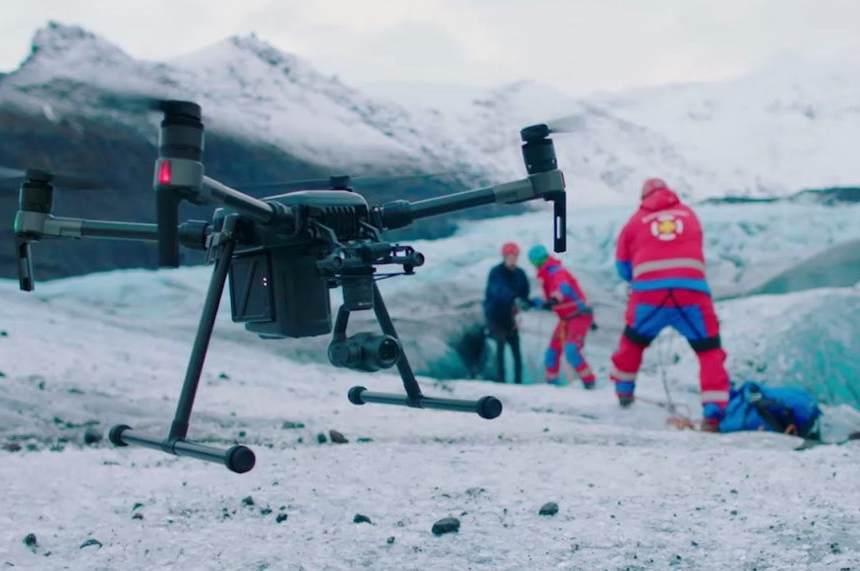
Drones are commonly used in a variety of geographical mapping and scientific research because they can fit in trickier areas, and they allow scientists and geographers to see areas they may not be used to. Along with that, drones may be used to inspect the safety measures taken in high-up buildings or other infrastructures. Law enforcement officials may also use drones to monitor large crowds.
Many people consider the LOPON GPS 4K Drone the best drone for beginners as the controller is easy to figure out and is a good quality drone for what you pay for.
On the other hand, professional drone users like the DJI Air 2S because it has a one-inch motion sensor, 5.4k video quality, and a 7.5-mile transmission range to boot. The only major downfall is that it’s quite an investment and is more costly than other quadcopter drones.
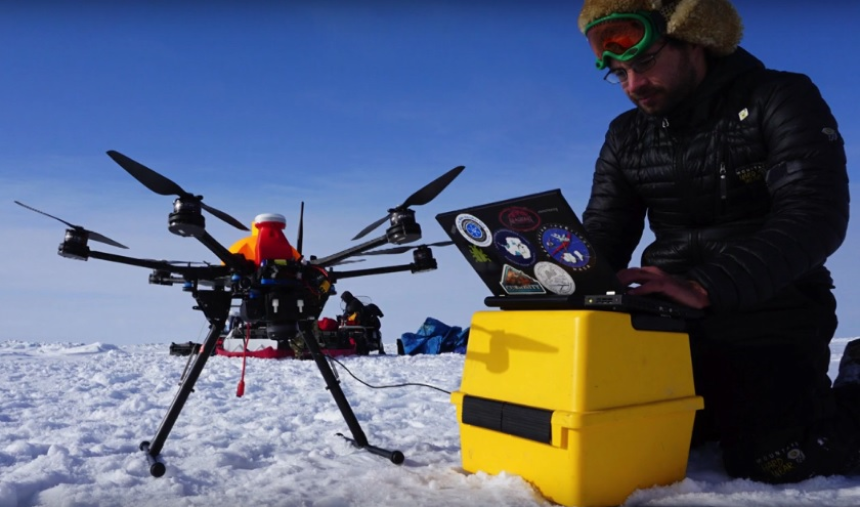 Motor and propeller direction explained
Motor and propeller direction explainedThinking about how the inner workings of a quadcopter allow it to move can feel a little confusing and intimidating. However, the process is much easier than one would think, and it’s relatively easy to get the hang of.
There are a number of things that come into play with how quadcopter propellers and motors work. Each part needs to work together in order to have a successful liftoff. As far as how it works, it’s easiest to reference Newton’s Third Law of Motion. Newton’s Third Law of Motion states that every action has an equal and opposite reaction.
In terms of
quadcopters
Trusted Source
ADVANCED AIR MOBILITY (AAM)
When most people think of aircraft, they usually think about airplanes that travel at great speeds and cover large distances while flying routes between airports. More and more, however, new types of aircraft are
transporting people and equipment to urban and rural locations where traditional airplanes cannot access.
This new aircraft range in size from small cargo-carrying drones to passenger-carrying air taxis, and carry out short-range missions.
www.nasa.gov
, the propellers go in two different directions: clockwise and counterclockwise. Two propellers will spin one way while the others spin the other way. As the propellers spin, the air is pushed downward, which allows thrust to lift the quadcopter off the ground. The “opposite reaction” here is gravity as it attempts to push down on the device.
In order for the quadcopter to fly, it needs to be capable of traveling in three different movement types: vertical, lateral, and rotational.
There are three main parts to a quadcopter’s control system: the central flight controller, the electronic speed control circuits (ESCs), and the drone propulsion system.
The central flight controller of a quadcopter is essentially the drone’s brain. This is what you use to guide your drone and tell it what to do. It also takes information from various parts of the drone, including the IMU, Gyroscope, GPS modules, and obstacle detection sensors.
In the case of many reviews, the most robust central flight controller is the DJJ Naza-M V2 Flight Controller. Reviewers also praise how durable the flight controller is and regularly praise the quality.
Electric Speed Control or ESC units are circuits that change the speed of an electric motor. It’s also responsible for changing routes and serves as a brake too. ESCs are designed with three different components in mind: a voltage regulator, a processor, and switching. The voltage regulator will separate the electronic speed control that will provide feedback to the receiver.
The voltage regulator may also hold some emergency battery life in the event that your quadcopter has a low charge and is in danger of crashing. The processor will decode any data given to it by the receiver and use what information is gathered to regulate power toward the motor.
The switching, or transistor, is what does all of the “dirty work” in your quadcopter. It performs all of the functions available to your device, and it observes the power from the motor and battery, as well as energy flow to various parts of the drone.
The ESC follows a speed reference signal that helps it decide when to speed up or slow down. When flying your quadcopter, you can switch the speeds on your controller, and it will send a message to transistors and other inner workings to act accordingly.
The drone’s motor bell is the part of the motor that actually rotates. Depending on the configuration of your quadcopter, the drone motor bell will rotate either clockwise or counter as two propellers move in each direction.
Other parts
Aside from the three main drone parts, there are two others that are integral in having a working quadcopter: the air gap and the drone’s motor windings. The air gap is found between the rotor and the stator. “Air gap” is just the name for the distance between these two parts.
The air gap is the main source of the low power factor in your drone’s operational system. It’s designed to be very small, and a large gap typically means negative functionality. The bigger the gap is, the more the magnetizing current will increase. This isn’t something you want happening, so it’s best to make sure the gap is as small as possible.
The windings, on the other hand, are simply the wiring inside the device. It’s typically made of copper coils and is usually wrapped around some type of coated, soft metalcore. They also form the magnetic poles that are energized when an electrical current comes through.
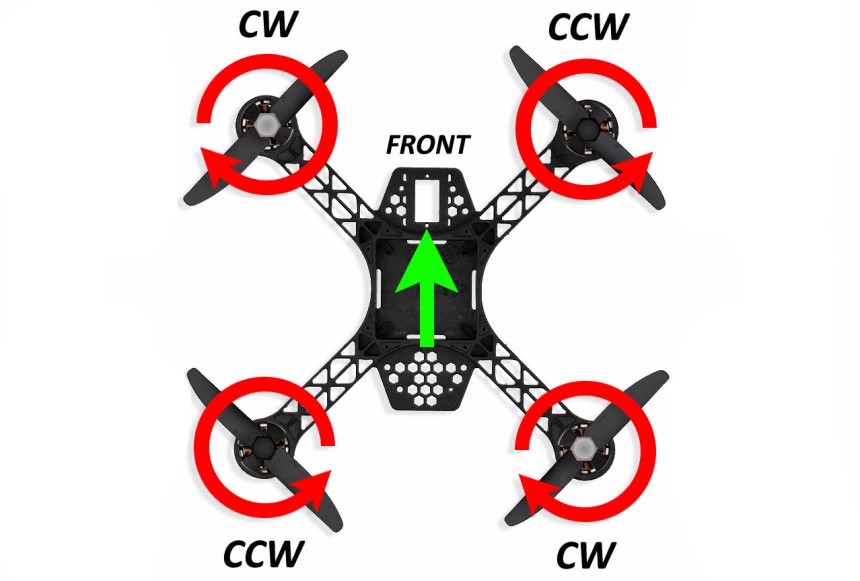
You can see that motors rotate in different directions.
There are two different directions a quadcopter’s motor propellers can rotate: clockwise (CW) and counterclockwise (CCW). For a quadcopter to work correctly, each opposite wheel will work opposite ways of the other. For example, an ideal quadcopter configuration would be:
In this situation, you can see that both left wheels have opposite rotations as well as the right wheels. Having that opposite rotation is the only way for a quadcopter or other drone to get the right thrust to lift off. After liftoff, most drones come with the ability to perform some types of tricks. While the names of these tricks may vary depending on the company, the general names behind them are yaw, pitch, and roll.
A vertical lift is the straight upwards lift commonly referred to as “liftoff.” To do this, each propeller works against its partner to create thrust. Thrust then works against Earth’s gravity to allow the quadcopter to fly in the air. Along with liftoff, there are three different functions that one can perform while the quadcopter is in a vertical lift position.
The first of these three is called “hover still.” When your quadcopter is hovering in one place, the net thrust of all four propellers is equal to the force of gravity. Because the force is equal from both sides, the quadcopter is able to suspend in the air.
The third and final function of the vertical list is “vertical descend.” This function is the opposite of climb ascends. While climb ascends uses speed to displace gravity’s thrust, vertically descend slows down to allow gravity’s thrust to displace that of the quadcopter.
When you want to fly your quadcopter forwards, backward, sideways, or in circles, these functions are completed by yaw, pitch, and roll. These three terms are used in any aircraft flying and are important terms to know if you plan on taking up droning as a new hobby.
For starts, “yaw” is what allows your drone to move either left or right. Yaw refers to the basic movement that spins the quadcopter. To complete this function, you typically just need to toggle the controller stick on your remote to the left or right, depending on the direction you want to go.
“Pitch” is the second of the three terms and refers to the act of moving the drone forward or backward. To move the quadcopter forward, you normally need to just toggle the control stick upward. If you want to go backward, you simply do the opposite and toggle the control stick down.
The third and final basic function is “roll.” Roll and yaw are commonly confused with one another, but they’re each unique in their functions. Roll is what allows your quadcopter to fly sideways rather than right side up. To use roll, you move the corresponding toggle to the left or right.
The yaw function controls the front of the drone and is what allows the quadcopter to move to the left or right. For example, the DJO Mavic 2 Pro has its yaw controls on the right control stick of the controller. When you move this stick to the right or left, you can see that it also moves the drone in whichever direction you choose.
The propeller direction for pitch and roll varies slightly as pitch sends the plane downward or upward while roll sends it side to side. In the case of pitch, the two front propellers slow down while the rear two propellers keep working as normal. When this happens, it allows your drone to move downward “face first.” You may also have the option to slow the rear propellers down instead. In this case, the quadcopter would move upward “head first.”
Now take that concept and apply it to the left or right propeller sets. If you want to lean your drone to the left, the left set of propellers will slow down. If you want to lean to the right, the right propellers will do so instead.
Before we suggest some popular quadcopter motor brands, we want to give you a little more information on how the motors work. After that, we’ll send you off with some recommendations of quadcopter motors that are popular in the drone community.
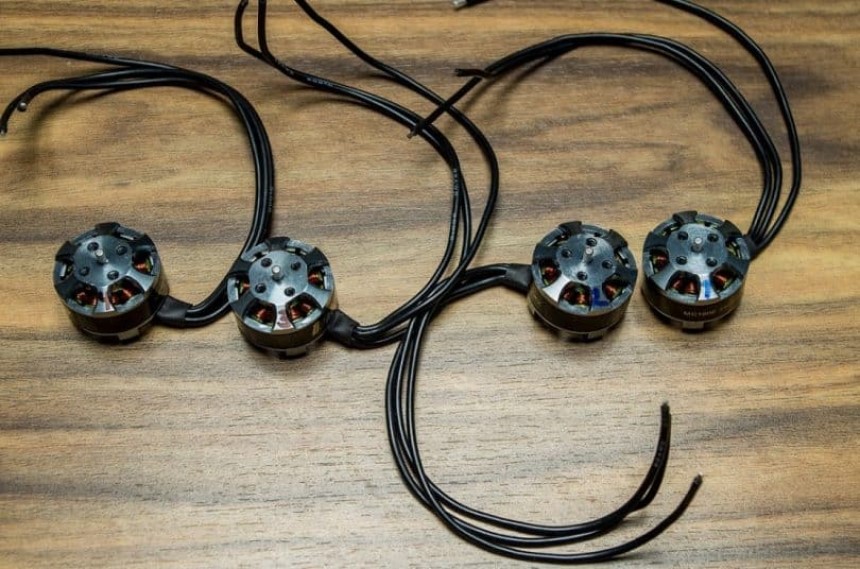
BLDC sensors also measure the circuit board that functions as the switch. Typically, the sensors used in a brushless motor are Hall sensors. Unlike regular DC motors, BLDC motors use permanent magnets on the rotor instead of the stator. The stator then holds the temporary electromagnets. A computer charges the electromagnets as the shaft turns. BLDCs are the more preferred option now for a number of reasons Trusted Source How does a brushless electric motor work? | HowStuffWorks The armature contains an electromagnet. When you run electricity into this electromagnet, it creates a magnetic field in the armature that attracts and repels the magnets in the stator. So the armature spins through 180 degrees. To keep it spinning, you have to change the poles of the electromagnet. The brushes handle this change in polarity. They make contact with two spinning electrodes attached to the armature and flip the magnetic polarity of the electromagnet as it spins. electronics.howstuffworks.com :
Although brushless motors typically cost more, they’re the more preferred option as you really get what you pay for, according to many drone users.
The propellers of a quadcopter move in two different directions at any given time. The opposing forces initiate thrust and actively work against the net thrust of Earth’s gravity to function how the person controlling sees fit.
Finding the right motor for a quadcopter can be a daunting process. While some companies claim to have amazing products, that isn’t always the case. Before buying a quadcopter motor, it’s imperative to do your own research and make sure you’re getting a food quality motor while also staying within your budget too. Let’s take a look at some of the most popular quadcopter motor brands.
DJI is headquartered in Shenzhen, which is considered the Silicon Valley of China. DJI prides itself on keeping creativity at the core of its business model and does this by committing to R&D, maintaining a culture of constant innovation and curiosity, and a laser focuses on transforming complex technology to become accessible to the general population.
DJI offers a variety of drones and quadcopters for both commercial and private use. Among the most popular quadcopters that DJI offers is the DJI Air 2S, according to many reviewers. This quadcopter has a one-inch sensor that helps minimize any noise levels, comes with a wide range of options for those interested in videography, and has a number of excellent AI features too. Those who have purchased the Air 2S say it’s incomparable when it comes to collision and tracking systems.
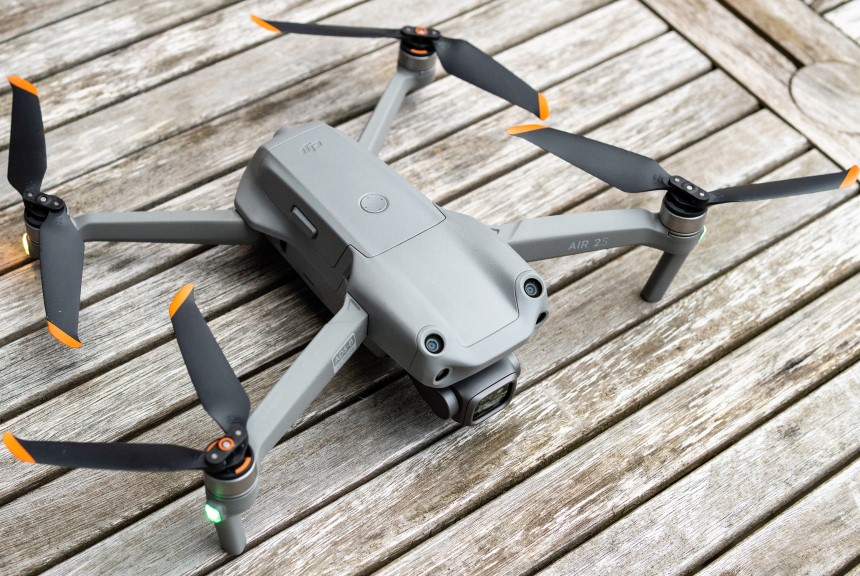
DJI drones have a smooth and modern design if you look for that as well.
T-Motor Company prides itself on its commitment to the profession, innovation, and passion. They do R&D with consistent pursuits of innovation and quality and inspect all products before sending them out to customers. The “T” in T-Motor is short for Tiger, which has relevant Chinese symbolism to how the company approaches its business model. In Chinese culture, the Tiger is representative of valor, boldness, and vigor.
This company produces advanced propulsion systems for UAVs. You’re likely to find motors, ESCs, and propellers here as that is their specialty. They offer a wide array of motors, but it seems the most popular one is the T-Motor F80 Pro. This motor is liked among customers because of its durability.
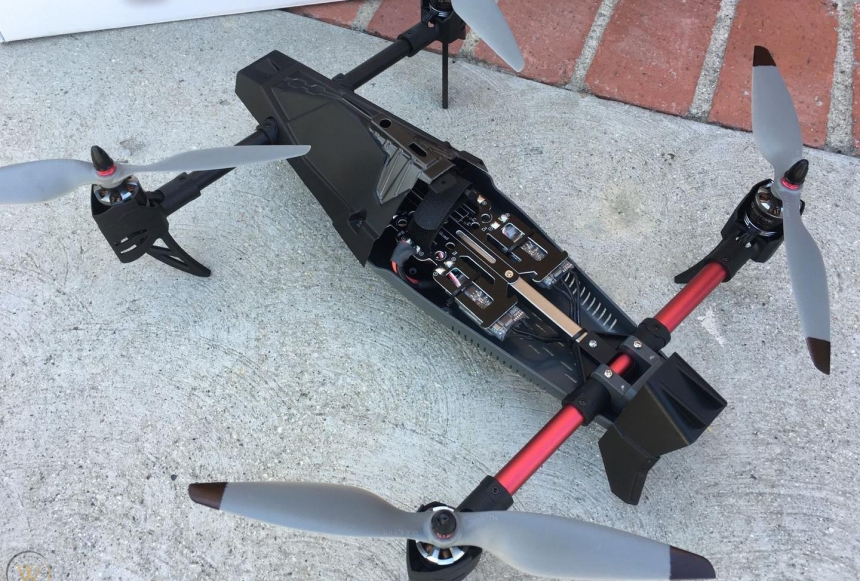 Quadcopter motor thrust calculators
Quadcopter motor thrust calculatorsA drone motor calculator helps you figure out the required amount of thrust needed to initiate liftoff for your quadcopter drone. Drone motor calculators Trusted Source Omni Calculator This drone motor calculator helps you determine the thrust required to get your drone up in the air. Whether you’re an amateur building his first drone, an aerobatics expert or a photographer, you will surely find this tool to be of help. www.omnicalculator.com are great tools for beginners and can even be helpful for experts too. The Drone motor calculator by OmniCalculator Trusted Source Omni Calculator It’s difficult to know the weight of your drone at the planning stage – after all, you didn’t choose the motors yet, so how can you determine their weight? Nevertheless, a reasonable estimate is sufficient for our drone thrust calculator. You can always adjust it later, once you know more about the construction of your multicopter. www.omnicalculator.com is the easiest and most helpful calculator we’ve found.
The propellers of a quadcopter are specially designed to function in different ways depending on their placement on the drone. Depending on what you want to do with your drone, you may want to buy or use a varying selection of propellers to get the desired effect. Here are some helpful things to keep in mind when contemplating quadcopter propellers.
Unsurprisingly, quadcopter propellers come in a variety of different sizes. It’s important to make sure you’re only buying high-quality propellers because those made with lower quality are more prone to vibration or damage. It’s easier to have issues with bigger propellers as they use more material and are more likely to hit things while flying.
The other measurements, on the other hand, take a bit more explaining. Prop pitch is an important measurement as they’re the prop dimensions of the propulsion system. The first number in the dimensions refers to propeller length. The second number refers to the pitch or the distance it can move forward in one single revolution.
The bore is the name for the hole in the middle of the propeller. This hole has to be matched to the shaft of your motor in order for everything to fit together correctly.
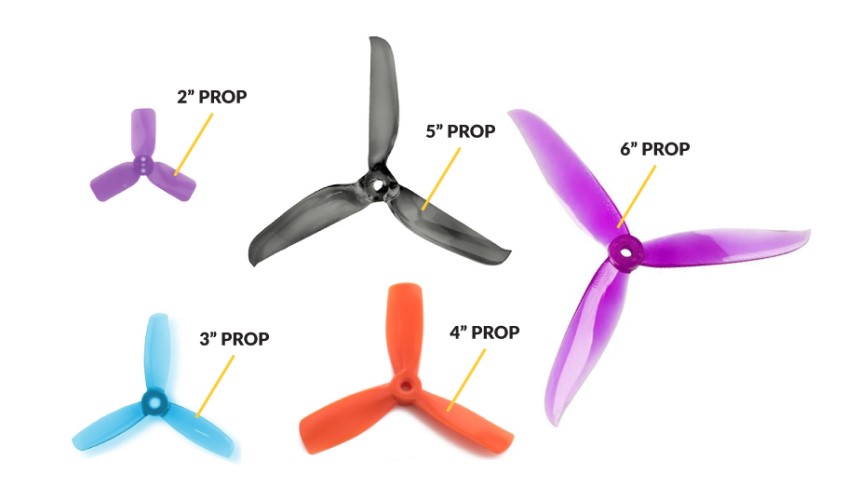 Large or small propellers
Large or small propellersIt’s generally preferred to use smaller propellers as larger propellers are more susceptible to damage. However, larger propellers are important if you need more air or thrust. Generally speaking, the greater the pitch, the higher the thrust will be.
Smaller propellers are also more favorable as they’re more efficient. Larger propellers take more energy to spin, but they also give more power. Despite that, smaller propellers allow you to fly your quadcopter faster because the motor isn’t overheating.
Clockwise and counterclockwise propellers are the only way you’ll be able to get your quadcopter to work properly. You need the opposing forces to work against each other in order for the net thrust from your quadcopter to overcome the net thrust of Earth’s gravitational pull.
Unlike wood propellers used in the past, modern-day quadcopter drone propellers typically use high-quality plastic or high-end carbon fiber. These materials are incredibly lightweight while still savoring efficiency.
When choosing good propeller blades, there are a few important things to keep in mind. Let’s explore these important factors a little right here:
Drone propellers spin in different directions to provide lift and stability. A quadcopter, for example, has four propellers, two of which rotate clockwise and two of which rotate counterclockwise.
You’ll need to find the connections that connect the motor to the electronic speed controller (ESC). Then swap any two of the three wires that are connected to the motor. This will reverse the direction of the motor.
Typically, two motors will spin clockwise and two motors will spin counter-clockwise on opposite sides of the hexacopter. This creates a balanced and stable flight, as well as provides the ability to control the hexacopter’s yaw (left and right rotation) and roll (tilting to the sides).
Quadcopters are a new and exciting hobby to pick up on your own or with another family. With that being said, it’s important to make sure you’re educated on everything that has to do with quadcopters so you can properly use it when it arrives.
By familiarizing yourself with aviation terms like yaw, pitch, and roll and bearing in mind the different parts of a quadcopter operation system, you’re less likely to run into any issues flying or trying to work your drone. Also, knowing and becoming familiar with these terms allow you to optimize your knowledge of quadcopter motor direction too.
No matter how old you get, RC devices like drones and other vehicles are fun for all. Whether you’re a professional or a hobbyist, we hope this article was helpful, and you’re leaving with a newfound knowledge of everything a person should know about quadcopters.